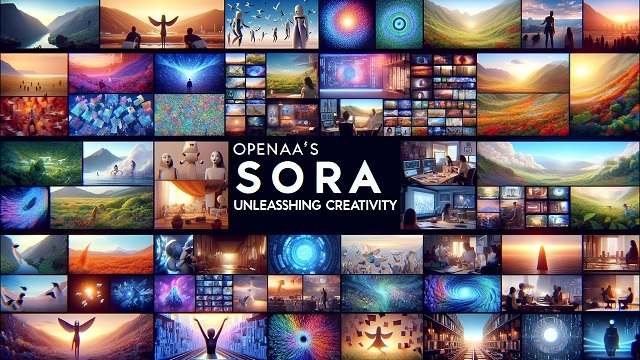
A new generative AI tool could transform video production and amplify disinformation risks
FEATURE | AGENCIES | OpenAI recently announced a new generative AI system named Sora, which produces short videos from text prompts. While Sora is not yet available to the public, the high quality of the sample outputs published so far has provoked both excited and concerned reactions.
The sample videos published by OpenAI, which the company says were created directly by Sora without modification, show outputs from prompts like “photorealistic closeup video of two pirate ships battling each other as they sail inside a cup of coffee” and “historical footage of California during the gold rush”.
At first glance, it is often hard to tell they are generated by AI, due to the high quality of the videos, textures, dynamics of scenes, camera movements, and a good level of consistency.
OpenAI chief executive Sam Altman also posted some videos to X (formerly Twitter) generated in response to user-suggested prompts, to demonstrate Sora’s capabilities.
Sora combines features of text and image generating tools in what is called a “diffusion transformer model”.
Transformers are a type of neural network first introduced by Google in 2017. They are best known for their use in large language models such as ChatGPT and Google Gemini.
Diffusion models, on the other hand, are the foundation of many AI image generators. They work by starting with random noise and iterating towards a “clean” image that fits an input prompt. A series of images emerge from static. A video can be made from a sequence of such images. However, in a video, coherence and consistency between frames are essential.
Sora uses the transformer architecture to handle how frames relate to one another. While transformers were initially designed to find patterns in tokens representing text, Sora instead uses tokens representing small patches of space and time.
Leading the pack
Sora is not the first text-to-video model. Earlier models include Emu by Meta, Gen-2 by Runway, Stable Video Diffusion by Stability AI, and recently Lumiere by Google.
Lumiere, released just a few weeks ago, claimed to produce better video than its predecessors. But Sora appears to be more powerful than Lumiere in at least some respects.
Sora can generate videos with a resolution of up to 1920 × 1080 pixels, and in a variety of aspect ratios, while Lumiere is limited to 512 × 512 pixels. Lumiere’s videos are around 5 seconds long, while Sora makes videos up to 60 seconds.
Lumiere cannot make videos composed of multiple shots, while Sora can. Sora, like other models, is also reportedly capable of video-editing tasks such as creating videos from images or other videos, combining elements from different videos, and extending videos in time.
Both models generate broadly realistic videos, but may suffer from hallucinations. Lumiere’s videos may be more easily recognised as AI-generated. Sora’s videos look more dynamic, having more interactions between elements.
However, in many of the example videos inconsistencies become apparent on close inspection.
Promising applications
Video content is currently produced either by filming the real world or by using special effects, both of which can be costly and time consuming. If Sora becomes available at a reasonable price, people may start using it as a prototyping software to visualise ideas at a much lower cost.
Based on what we know of Sora’s capabilities it could even be used to create short videos for some applications in entertainment, advertising and education.
OpenAI’s technical paper about Sora is titled “Video generation models as world simulators”. The paper argues that bigger versions of video generators like Sora may be “capable simulators of the physical and digital world, and the objects, animals and people that live within them”.
If this is correct, future versions may have scientific applications for physical, chemical, and even societal experiments. For example, one might be able to test the impact of tsunamis of different sizes on different kinds of infrastructure – and on the physical and mental health of the people nearby.
Achieving this level of simulation is highly challenging, and some experts say a system like Sora is fundamentally incapable of doing it.
A complete simulator would need to calculate physical and chemical reactions at the most detailed levels of the universe. However, simulating a rough approximation of the world and making realistic videos to human eyes might be within reach in the coming years.
Risks and ethical concerns
The main concerns around tools like Sora revolve around their societal and ethical impact. In a world already plagued by disinformation, tools like Sora may make things worse.
It’s easy to see how the ability to generate realistic video of any scene you can describe could be used to spread convincing fake news or throw doubt on real footage. It may endanger public health measures, be used to influence elections, or even burden the justice system with potential fake evidence.
Video generators may also enable direct threats to targeted individuals, via deepfakes – particularly pornographic ones. These may have terrible repercussions on the lives of the affected individuals and their families.
Beyond these concerns, there are also questions of copyright and intellectual property. Generative AI tools require vast amounts of data for training, and OpenAI has not revealed where Sora’s training data came from.
Large language models and image generators have also been criticised for this reason. In the United States, a group of famous authors have sued OpenAI over a potential misuse of their materials. The case argues that large language models and the companies who use them are stealing the authors’ work to create new content.
It is not the first time in recent memory that technology has run ahead of the law. For instance, the question of the obligations of social media platforms in moderating content has created heated debate in the past couple of years – much of it revolving around Section 230 of the US Code.
While these concerns are real, based on past experience we would not expect them to stop the development of video-generating technology. OpenAI says it is “taking several important safety steps” before making Sora available to the public, including working with experts in “misinformation, hateful content, and bias” and “building tools to help detect misleading content”.
How Sora works
Sora is a text-to-video model that significantly advances the integration of deep learning, natural language processing and computer vision to transform textual prompts into detailed and coherent life-like video content.
At the heart of Sora’s innovation is a technique that transforms visual data into a format it can easily understand and manipulate, similar to how words are broken down into tokens for AI processing by text-based applications.
This process involves compressing video data into a more manageable form and breaking it down into patches or segments. These segments act like building blocks that Sora can rearrange to create new videos.
Sora uses a combination of deep learning, natural language processing and computer vision to achieve its capabilities.
Deep learning helps it understand and generate complex patterns in data, natural language processing interprets text prompts to create videos, and computer vision allows it to understand and generate visual content accurately.
By employing a diffusion model – a type of model that’s particularly good at generating high-quality images and videos — Sora can take noisy, incomplete data and transform it into clear, coherent video content.
Sora’s approach differs from CGI character creation, which requires extensive manual effort, and from traditional deepfake technologies, which often lack ethical safeguards, by offering a scalable and adaptable method for generating video content based on textual input.
What does this mean for businesses?
One of the most noteworthy aspects of Sora is its flexibility, as it supports various video formats and sizes, enhances framing and composition for a professional finish, and accepts text, images or videos as prompts for animating images or extending videos.
The emergence of Sora presents key opportunities for businesses across different sectors. In the near future, there are two key areas that may have significant applications.
The first area is in marketing and advertising. Just as ChatGPT has become a marketing and content creation tool, we can expect businesses to use Sora for similar reasons.
With the public release of Sora, brands and companies will be able to create highly engaging and visually appealing video content for marketing campaigns, social media and advertisements.
The ability to generate custom videos based on textual prompts will allow for greater creativity and personalization, possibly helping brands stand out in a crowded market.
A video from OpenAI of an AI-generated video from Sora. The prompt was: ‘A beautiful homemade video showing the people of Lagos, Nigeria in the year 2056. Shot with a mobile phone camera.’
The second area Sora could impact is training and education. Companies could use Sora to develop educational and training videos that are tailored to specific topics or scenarios. This could enhance the learning experience for employees and customers, making complex information more accessible and engaging.
Other sectors, such as e-commerce, also hold promising potential for the future application of Sora. Retailers could create dynamic product demonstrations that effectively showcase products in a more engaging and interactive manner.
This would be especially beneficial for companies that want to highlight specific aspects of products that might not be easily conveyed through static images or text, or for advertising products that require a detailed explanation.
Sora could also significantly reduce the uncertainty associated with online shopping by facilitating virtual try-on experiences, allowing customers to visualize how a product, such as clothing or accessories, would look on them without the need for a physical fitting. This, in turn, could result in a better return on investment.
*****
Source: The Conversation
 The Independent Uganda: You get the Truth we Pay the Price
The Independent Uganda: You get the Truth we Pay the Price


